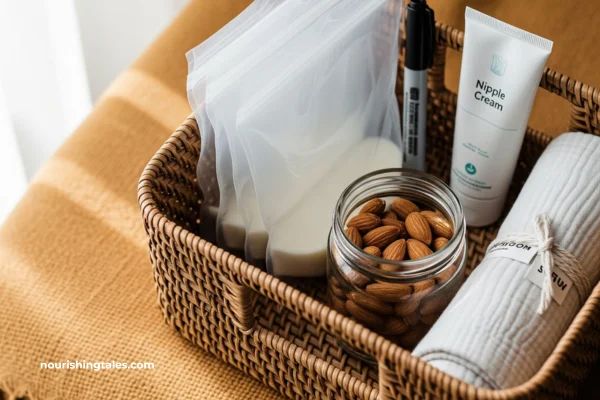Your pumping journey in the first month begins with understanding that you’ve just done something incredible, and now you’re looking at this new machine with all its tubes and parts, starting a whole new journey. It’s completely normal to feel a mix of hope, confusion, and maybe even a little bit of fear. You are not alone in this.
Before we dive in, let’s get one thing straight: the first month of pumping is a learning curve, not a competition. Your social media might be full of freezers overflowing with milk, but please know, that is not the goal right now. Your job isn’t to fill bottles; it’s to teach your body that your baby is here and needs nourishment. It’s all about connection and stimulation.
So let’s walk through this first month together, week by week. Think of us as a caring friend who’s also an expert, here to support you every step of the way.
Week 1 (Part 1): The First Few Days & Liquid Gold
This is ground zero. Whether you’re pumping because your baby is in the NICU, you’re navigating latching challenges, or you’re choosing to exclusively pump, these first 72 hours are crucial for sending the “let’s make milk!” signal to your body.
What to Expect: Tiny Amounts of Liquid Gold
Right now, you’re producing colostrum. We call it “liquid gold” for a reason! This thick, yellowish substance is low in volume but bursting with antibodies and nutrients—the perfect first food for your baby.
- You will see very little milk. You might only get a few drops clinging to the pump flange or collect just 5-7 ml per session. Many mothers see this and panic, but this is exactly right.
- Your baby’s tummy is tiny. It’s only the size of a small marble, so this small, concentrated amount is precisely what they need. You’ll likely be collecting it in a small syringe, not a bottle.
Your Goal: Stimulation, Not Volume
Forget about the measurements on the bottle. Your only job is to stimulate your breasts frequently and consistently. You are placing an order for your future milk supply.
- Pump every 2-3 hours, around the clock. Yes, that means setting alarms for the middle of the night. This mimics a newborn’s natural feeding pattern.
- Pump for 15-20 minutes each time. Even if milk stops flowing, keep the pump going for the full duration. This continued stimulation is the message your body needs to hear.
- Use your hands. Gently massage your breasts before and during your pumping session. This “hands-on pumping” is a fantastic habit that can help you express more of that thick colostrum.
Week 1 (Part 2): Your Milk Comes In
Sometime between day 3 and day 5, you’ll feel a definite shift. This is when your mature milk starts to arrive.
What to Expect: Fullness and a Volume Spike
You might wake up one morning to find your breasts are suddenly full, firm, and warm. This is called engorgement, and while it can be uncomfortable, it’s a wonderful sign that your body is responding beautifully.
- You’ll see more milk. The colostrum will transition to a thinner, whiter milk. You might now be pumping 30-60 ml per session.
- Discomfort is normal, but manageable. Your breasts might feel tender and heavy.
Your Goal: Create a Consistent Schedule
Your body is now working on a “supply and demand” system. You must remove milk regularly to tell your body to keep making it.
- Aim for 8-12 pumping sessions every 24 hours. This is the magic number in the early weeks to build a robust supply. A common schedule is to pump every 3 hours (e.g., 6 am, 9 am, 12 pm, etc.).
- Manage engorgement. Use a warm compress before pumping to help the milk flow and a cold compress after pumping to reduce swelling and discomfort.
- Nourish yourself. Drink plenty of water and eat regular, wholesome meals. You are the power source for this entire operation!
Weeks 2 & 3: Finding Your Pumping Rhythm
This can be the toughest stretch. The initial adrenaline wears off, and the reality of the relentless schedule sets in, all while you’re navigating life with a newborn on very little sleep. Be extra gentle with yourself.
What to Expect: Ups and Downs
Your milk supply is beginning to regulate, which means your body is learning exactly how much milk your baby needs.
- Your output will fluctuate. It’s completely normal for one session to yield more milk than another. Most mums find their first pump of the morning is their largest—this is thanks to the milk-making hormone prolactin, which peaks overnight.
- Soreness might creep in. As you settle into a routine, you might notice some discomfort. This is your cue to troubleshoot.
Your Goal: Prioritise Comfort and Protect Your Sanity
Making this journey sustainable is the key.
- If it hurts, get help. Seriously. Pain is not a normal part of this process. So often, mums are told to just push through it, but please know that pumping shouldn’t hurt. It’s a sign that something needs adjusting.
- Check your flange size. The number one cause of pumping pain is an incorrect flange size. That little plastic tunnel should fit your nipple just right—not too tight, not too loose.
- Look at the big picture. It’s easy to get discouraged by one low-volume pump. Instead of focusing on a single session, track your total output over a 24-hour period. If you’re ever worried about your output, know that there are gentle and effective ways to increase your milk supply.
Week 4: Building Confidence & a Sustainable Routine
You’ve made it through the hardest part! By now, the whole process of setting up, pumping, and cleaning is starting to feel like second nature. You’ve got this.
What to Expect: A More Predictable Supply
The wild fluctuations should begin to level out, and you’ll have a much better sense of your body’s daily rhythm.
- You might have a little extra. This is often when mums find they are pumping slightly more than their baby needs, allowing them to start a small freezer stash for peace of mind.
- You feel more in control. You know your pump’s settings, you have a system for washing parts, and the process feels far less daunting than it did on day one.
Your Goal: Settle In and Celebrate Yourself
You’ve established your supply. Now it’s about making this work for you.
- Introduce a bottle if you haven’t already. If you want others to be able to help with feedings, this is a great time to introduce a bottle. We highly recommend using paced bottle feeding techniques, which mimic breastfeeding and give your baby more control.
- Acknowledge your hard work. Look back at where you were on day one, carefully collecting those precious drops. Now you are providing full meals for your baby with your body and your dedication. That is nothing short of amazing.
Remember This, Mama
If you take anything away from this guide, let it be these truths:
- Your worth is not measured in millilitres. Your love, your touch, and your presence are what your baby needs most.
- Your journey is your own. Do not compare your day-one output to someone else’s month-six freezer stash. You are right where you need to be.
- Consistency trumps volume. Showing up for those 8-12 daily sessions is what builds and protects your supply for the long run.
Congratulations, you have navigated the first month—unquestionably one of the most demanding phases of your journey. You’ve laid the foundation, and it only gets easier from here. Keep going, be kind to yourself, and know that you are doing a phenomenal job.
Disclaimer: This article is for informational purposes only and does not constitute medical advice. Please consult with a qualified healthcare professional or an International Board Certified Lactation Consultant (IBCLC) for personalised advice regarding your health and your baby’s needs.




